check engine GMC JIMMY 1997 User Guide
[x] Cancel search | Manufacturer: GMC, Model Year: 1997, Model line: JIMMY, Model: GMC JIMMY 1997Pages: 410, PDF Size: 20.03 MB
Page 192 of 410
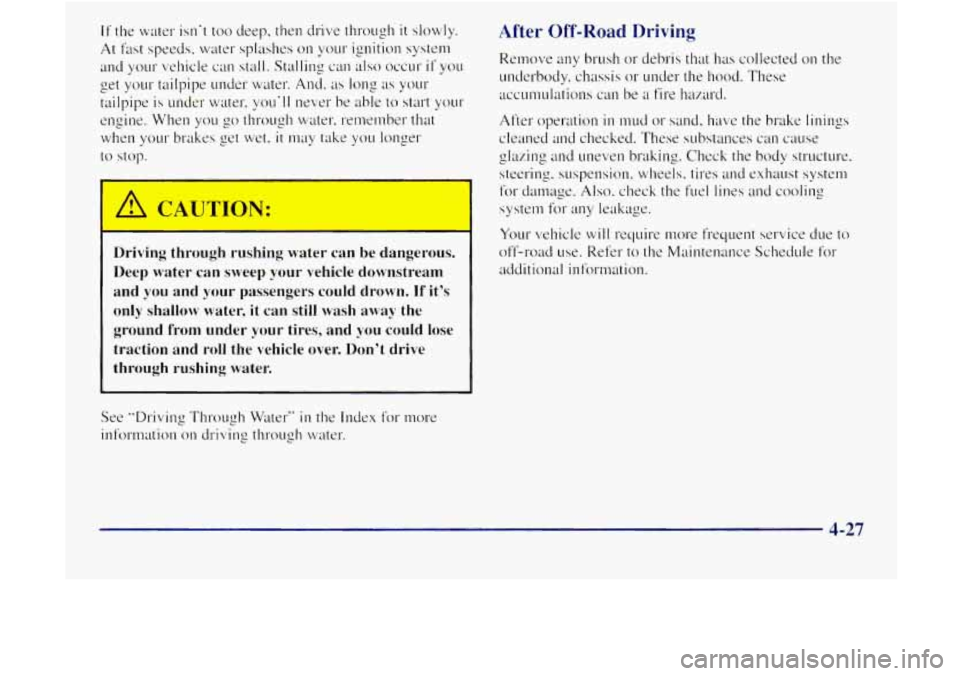
If the water isn't too deep, then drive through it slowly.
At fast speeds, water splashes on your ignition system
and
your vehicle can stall. Stalling can dso occur if you
tailpipe is under water, yo~l*II never be able to start your
engine. When
you go through water. remember that
when your brakes get
wet. it nay take you longer
to stop.
2 wt your tailpipe under water. And. as long as your
Driving through rushing water can be dangerous. Deep water can sweep your vehicle downstream
and
you and your passengers could drown. If it's
only shallow water, it can still wash away the
ground from under your tires, and you could lose
traction and roll the vehicle over. Don't drive
through rushing water.
After Off-Road Driving
Relmove any brush or debris that has collected on the
underbody. chassis or 11nder the hood. These
accumulations CUI be a fire hazard.
After operation
in mud or sand. have the brake linings
cleaned and checked. These substances can C~LIS~
glazing and 1111even braking. Check the body structure.
steering. suspension. wheels, tires and exlxwst system
for damage.
Also. check the fuel lines and cooling
system for any leakage.
Your
vehicle will require more frequent service due to
off-road use. Refer to the Maintenance Schedule for
additional information.
4-27
Page 200 of 410

Highway Hypnosis
Is there actually such a condition as "highway hypnosis'"?
Or is
it just plain falling asleep at the wheel'? Call it
highway hypnosis, lack of awareness, or whatever.
There
is something about an easy stretch of road with
the same scenery, along with the hum of the tires on the
road, the drone of the engine. and the rush of the wind
against the vehicle that can make you sleepy. Don't let
it
happen to you! If it does, your vehicle can leave the
road
in less than cf soc-ond, and you could crash and
be injured.
What can you
do about highway
aware that
it can happen.
Then here are some tips:
0 Make sure your vehicle is we1
comfortably cool interior. 1ypmsis'?
First. be
0
0
I ventilated. with a
Keep your eyes moving. Scan the road ahead and
to the sides. Check your mirrors and your
instruments frequently.
If you get sleepy, pull off the road into a rest. service
or parking area and take
a nap, get some exercise, or
both.
For safety, treat drowsiness on the highway as
an emergency.
Hill and Mountain Roads
Driving on steep hills or nlountains is different from
driving
in flat or rolling terrain.
If you drive regularly in steep country, or if you're
planning
to visit there, here are some tips that can make
your trips safer
and more enjoyable. (See "Off-Road
Driving"
in the Index for information about driving
off-road.
)
4-35
Page 201 of 410
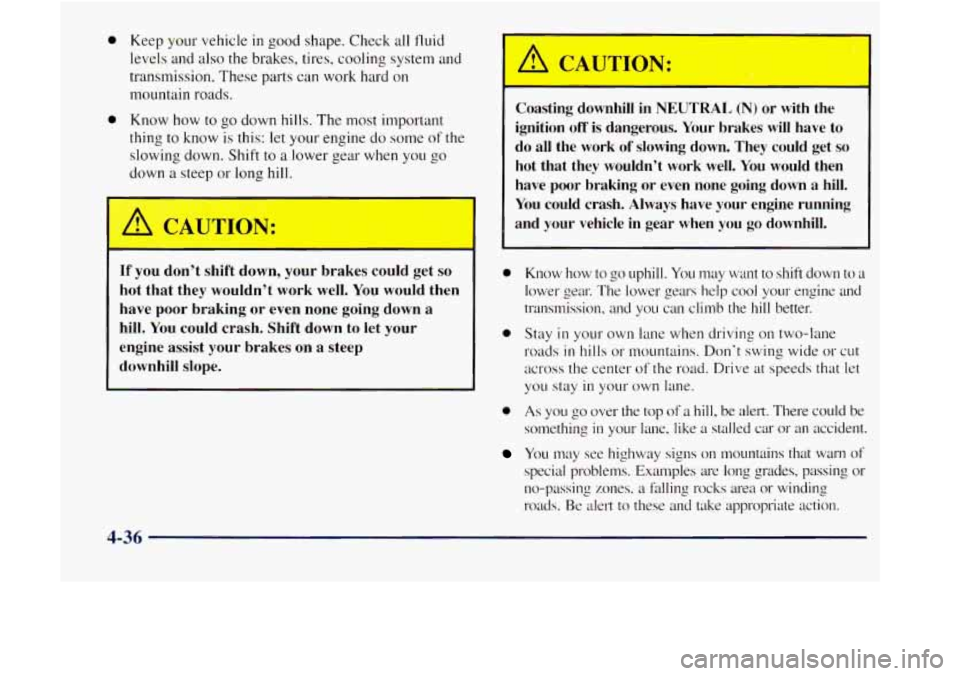
0
0
Keep your vehicle in good shape. Check all fluid
levels and also
the brakes, tires, cooling system and
transmission. These parts can work hard on
mountain roads.
Know
how to go down hills. The most important
thing to know is this:
let your engine do some of the
slowing down.
Shift to a lower gear when you go
down a steep or long hill.
If you don’t shift down, your brakes could get so
hot that they wouldn’t work well. You would then
have poor braking or even none going down
a
hill. You could crash. Shift down to let your
engine assist your brakes on
a steep
downhill slope.
A CAUTION: . -.
Coasting downhill in NEUTRAL (N) or with the
ignition
otf is dangerous. Your brakes will have to
do all the work
of slowing down. They could get so
hot that they wouldn’t work well. You would then
have poor braking or even none going down a hill.
You could crash. Always have your engine running
and your vehicle in gear when
you go downhill.
0 Know how to go uphill. You may want to shift down to a
lower gear. The lower gears help cool yo~~r engine and
transmission, and you can climb the hill better.
0 Stay in your own lane when driving on two-lane
roads
in hills or mountains. Don’t swing wide or cut
across the center
of the road. Drive at speeds that let
you stay
in your own lane.
0 As you go over the top of a hill, be alert. There could be
something
in your lane, like a stalled car or an accident.
You may see highway signs on nmuntains that warn of
special problems. Examples are long grades, passing or
no-passing zones. a falling rocks area or winding
roads.
Be alert to these and take appropriate action.
4-36
Page 205 of 410

Snow can trap exhaust gases under your vehicle.
This can cause deadly
CO (carbon monoxide) gas
to get inside.
CO could overcome you and kill
you. You can’t see it or smell it,
so you might not
know it is in your vehicle. Clear away snow from
around the base of your vehicle, especially any
that is blocking your exhaust pipe. And check
around again from time to time to be sure snow
doesn’t collect there.
Open a window just a little on the side of the
vehicle that’s away from the wind. This will help
keep
CO out.
Run your engine only as long as you must. This saves
fuel. When
you run the engine, make it go a little faster
than just idle. That is, push the accelerator slightly.
This
uses less fuel for the heat that you get and it keeps the
battery charged.
You will need a well-charged battery to
restart the vehicle. and possibly for signaling later on
with your headlamps. Let the heater run for a while.
Then, shut the engine
off and close the window almost
all the way
to preserve the heat. Start the engine again
and repeat this only when you feel really uncomfortable
from the cold.
But do it as little as possible. Preserve the
fuel as long
as you can. To help keep warm, you can get
out of the vehicle and
do some hirly vigorous exercises
every half
hour or so until help comes.
4-40
Page 217 of 410
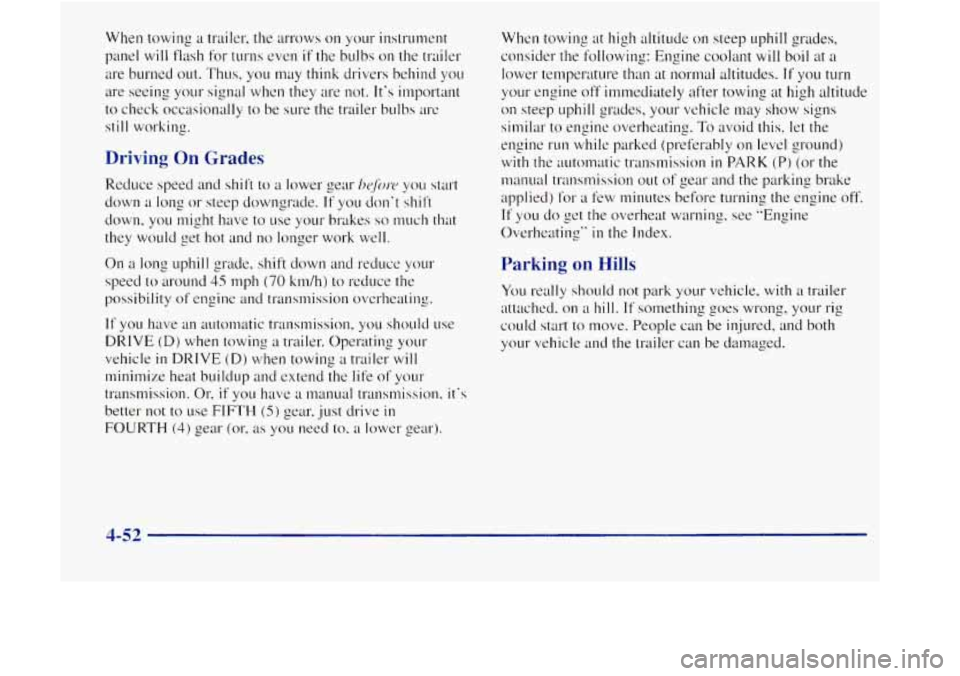
When towing a trailer, the ~~rrows on your instrument
panel
will flash for turns even if the bulbs on the trailer
itre burned out. Thus. you may think drivers behind you
are seeing your signal when they are not. It's important
to check occasionally to be sure the trailer bulbs arc
still working.
Driving On Grades
On a long uphill grade, shift down and reducc your
speed
to around 45 mph (70 km/h) to reduce the
possibility
of engine and transmission ovc.rheating.
If you have an automatic transmission. you should use
DRIVE
(D) when towing a trailer. Operating your
vehicle
in DRIVE (D) when towing a trailer will
minimize heat buildup and extend the life
of your
trrmsmission. Or:
if you have ;1 manual transmission. it's
better not to use FIFTH (5) gear. just drive in
FOURTH (4) gear (or, as you need to, a I~MW gear). Whcn
towins at high altitude
on steep uphill grades,
consider the following: Engine coolant will boil at a
lower temperature than at normal altitudes. If yo^^ turn
your engine off immediately after towing
at high altitude
on steep uphill grades, your \:ellicle may show signs
similar to engine overheating.
To avoid this. let the
engine
r~~n while parked (preferably on level grout1d)
with the automatic transmission in PARK (Pj (or the
1manuaI transmission out of
gear and the parking brake
applied) 1'01-
;I few minutes before turning the engine off.
If you do get the overheat warning. see "Engine
Overheating"
in the Index.
Parking on Hills
You really should not park your vehicle. with a trailer
attached.
on a hill. If something goes wrong, your rig
could start
to move. People can be injured, and both
yo~~r vehicle and the trailer can
be damaged.
4-52
Page 219 of 410
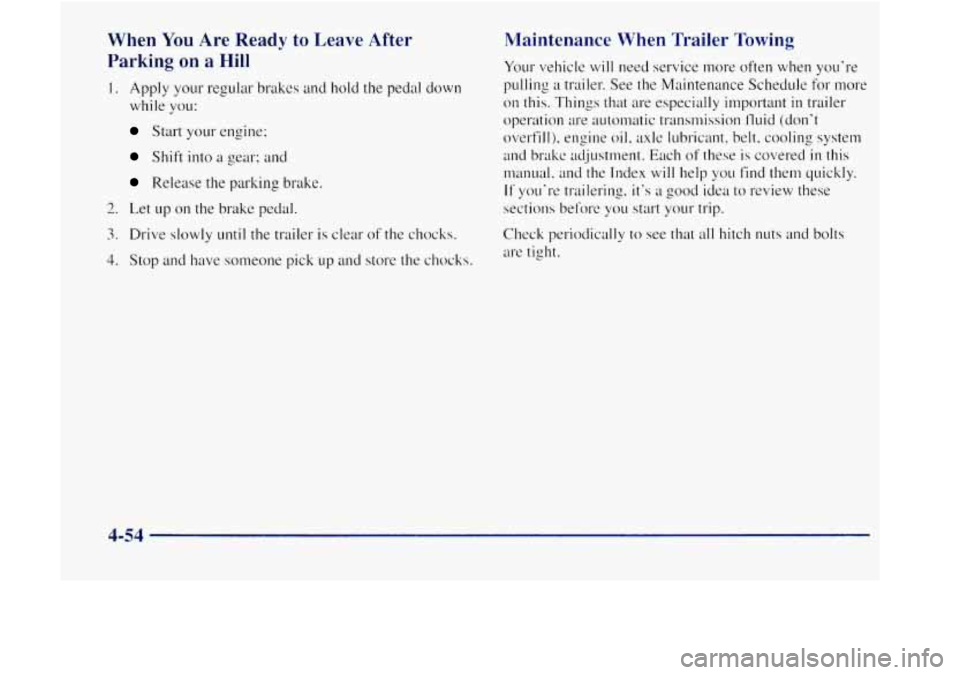
When You Are Ready to Leave After
Parking on
a Hill
I, Apply your reg~~lar brakes and lwld the pedal down
while you:
Start your engine;
Shift into a gear: and
Release the parking brake.
2. Let up on the brake pedal.
3. Drive slowly until the trailer is clear of the chocks.
4. Stop and have someone pick up and store the chocks.
Maintenance When Trailer Towing
Your vehicle will need service nlore often when you're
pulling a trailer. See the Maintenance Schedule for more
on
this. Things that are especially important in trailer
operation
are automatic transmission fluid (don't
overfill), engine
oil. ~~xle lubricant, belt, cooling system
and
brakc adjustment. Each of these is covered in this
manurd.
and the Index will help you find then] quickly.
If you're trailering. it's a good idea to review these
sections before you start your trip.
Check periodically
to see that all hitch nuts and bolts
are tight.
4-54
Page 263 of 410
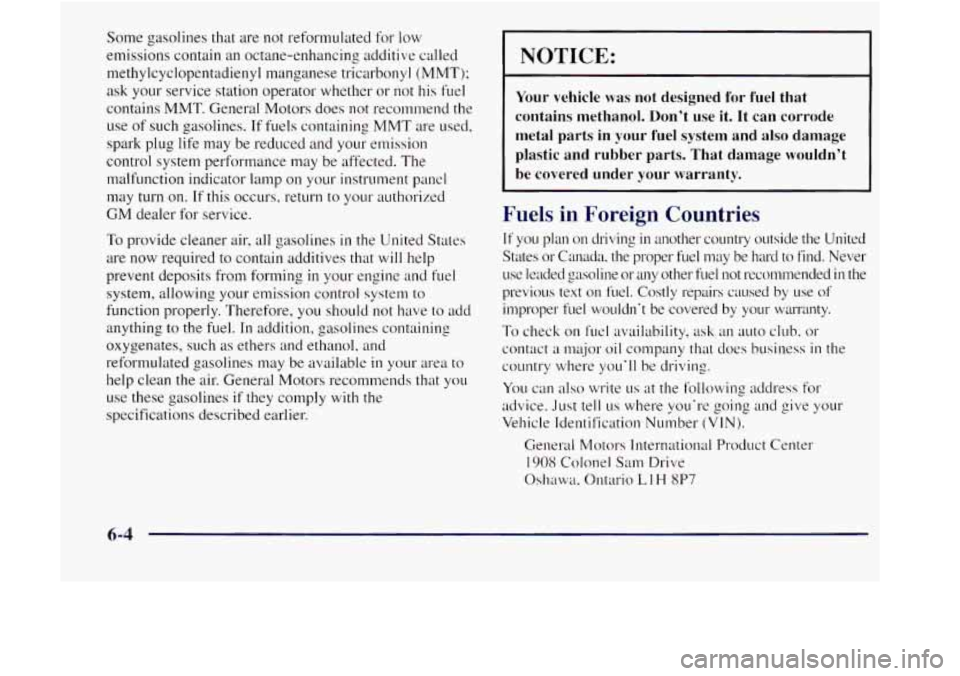
Some gasolines that are not reformulated for low
emissions contain an octane-enhancing additive called
methylcyclopentadienyl manganese tricarbonyl
(MMT):
ask your service station operator whether or not his fuel
contains MMT. General Motors does not recommend the
use
of such gasolines. If fuels containing MMT are used,
spark plug life may be reduced and your emission
control system performance
may be affected. The
malfunction indicator lamp on your instrument panel
may turn on.
If this occurs, return to your authorized
GM dealer for service.
To provide cleaner ail-, all gasolines in the United States
are now required
to contain additives that will help
prevent deposits from forming
in your engine and fuel
system, allowing; your emission control system to
function properly. Therefore, you should not have
to add
anything
to the fuel. In addition, gasolines containing
oxygenates, such as ethers and ethanol, and
reformulated gasolines may be available
in your area to
help clean the air. General Motors recommends that you
use these gasolines if they comply with the
specifications described earlier.
I NOTICE:
Your vehicle was not designed for fuel that
contains methanol. Don’t use it. It can corrode
metal parts in your fuel system and also damage
plastic and rubber parts. That damage wouldn’t
be covered under your warranty.
Fuels in Foreign Countries
If you plan on driving in another country outside the United
States or Canada, the proper fuel may be hard to find. Never
use leaded gnsooline or any other fuel not recommended
in the
previous text on fuel. Costly repairs caused by use of
improper fuel wouldn’t be covered by your warranty.
To check on ~w1 availability, ask an auto club, or
contact a nlajor oil company that does business in the
country where you’ll be driving.
You can also write us at the following address for
advice. Just tell us where you-re going and give your
Vehicle Identil’ication Number
(VIN).
General Motors International Product Center
1908 Colonel Sam Drive
Osha~/a. Ontario
L 1 H 8P7
6-4
Page 268 of 410
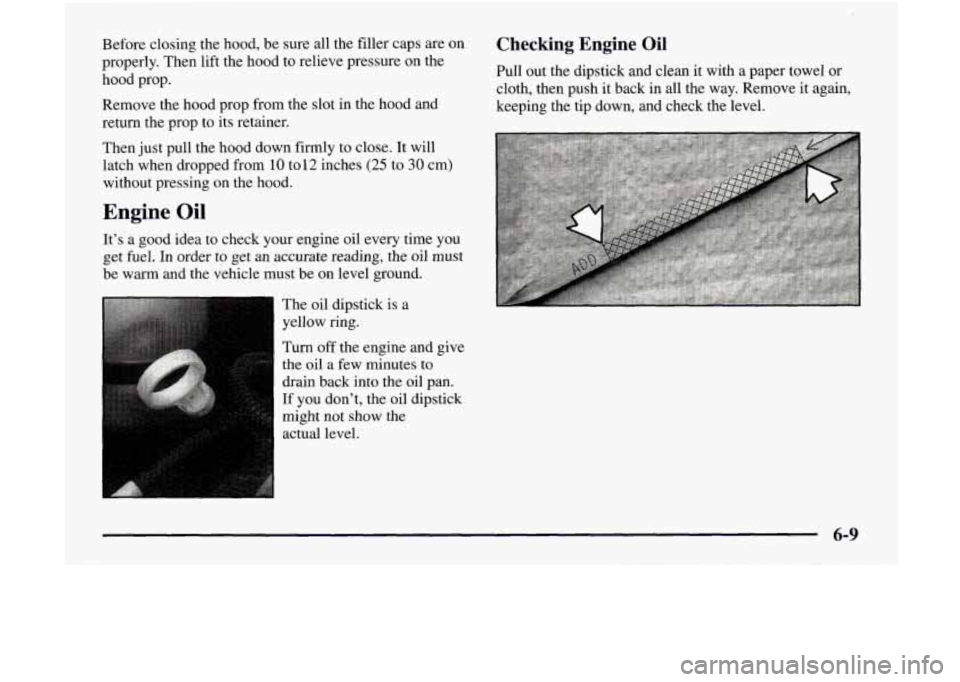
Before closing the hood, be sure all the filler caps are on
properly. Then lift the hood to relieve pressure on the
hood prop.
Remove the hood prop from the slot in the hood and
return the prop to its retainer.
Then just pull the hood down firmly to close. It will
latch when dropped from
10 to12 inches (25 to 30 cm)
without pressing on the hood.
Engine Oil
It’s a good idea to check your engine oil every time you
get fuel.
In order to get an accurate reading, the oil must
be warm and the vehicle must be on level ground.
The oil dipstick is a
yellow ring.
Turn
off the engine and give
the oil
a few minutes to
drain back into the oil pan.
If you don’t, the oil dipstick
might not show the
actual level.
Checking Engine Oil
Pull out the dipstick and clean it with a paper towel or
cloth, then push it back in
all the way. Remove it again,
keeping the tip down, and check the level.
6-9
Page 273 of 410
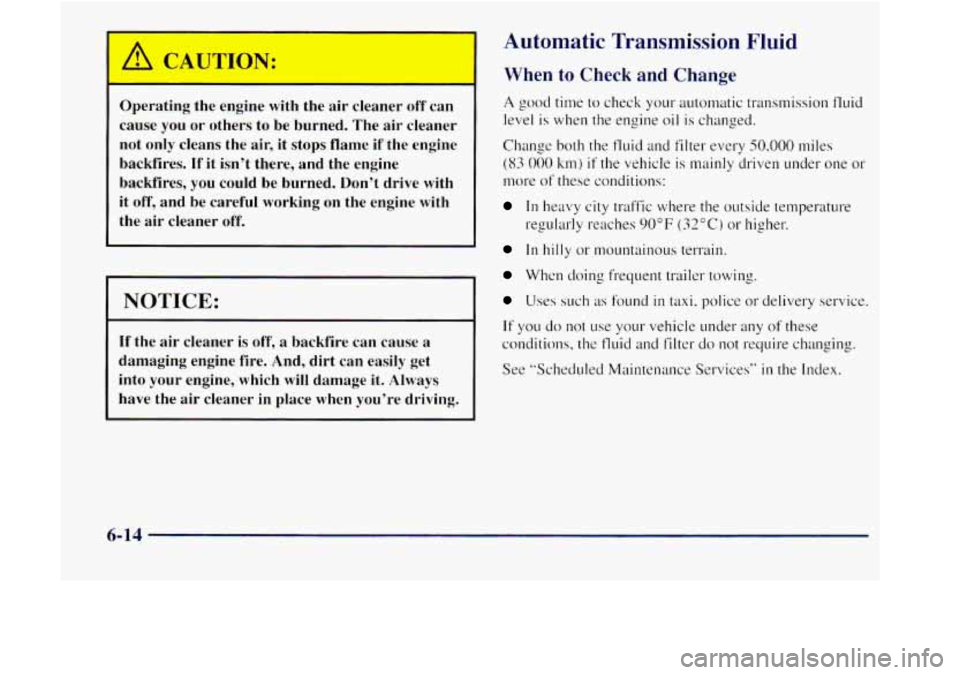
Automatic Transmission Fluid
Operating the engine with the air cleaner off can
cause you or others
to be burned. The air cleaner
not only cleans the air, it stops flame
if the engine
backfires.
If it isn't there, and the engine
backfires, you could be burned. Don't drive with
it
off, and be careful working on the engine with
the air cleaner
off.
I NOTICE:
If the air cleaner is off, a backfire can cause a
damaging engine fire. And, dirt can easily get
into your engine, which
will damage it. Always
have the air cleaner
in place when you're driving.
When to Check and Change
A good time to check your automatic transmission fluid
level is when the engine oil is changed.
Change both the fluid
and filter every 50.000 miles
(83 000 km) if the vehicle is mainly driven under one or
more of these conditions:
In heavy city traffic where the outside temperature
regularly reaches
90°F (32°C) or higher.
In hilly or mountainous terrain.
When doing frequent trailer towing.
Uses such as found in taxi. police or delivery service.
If you do not use your vehicle under any of these
conditions, the fluid and filter do not require changing.
See "Scheduled Maintenance Services"
in the Index.
6-14
Page 274 of 410
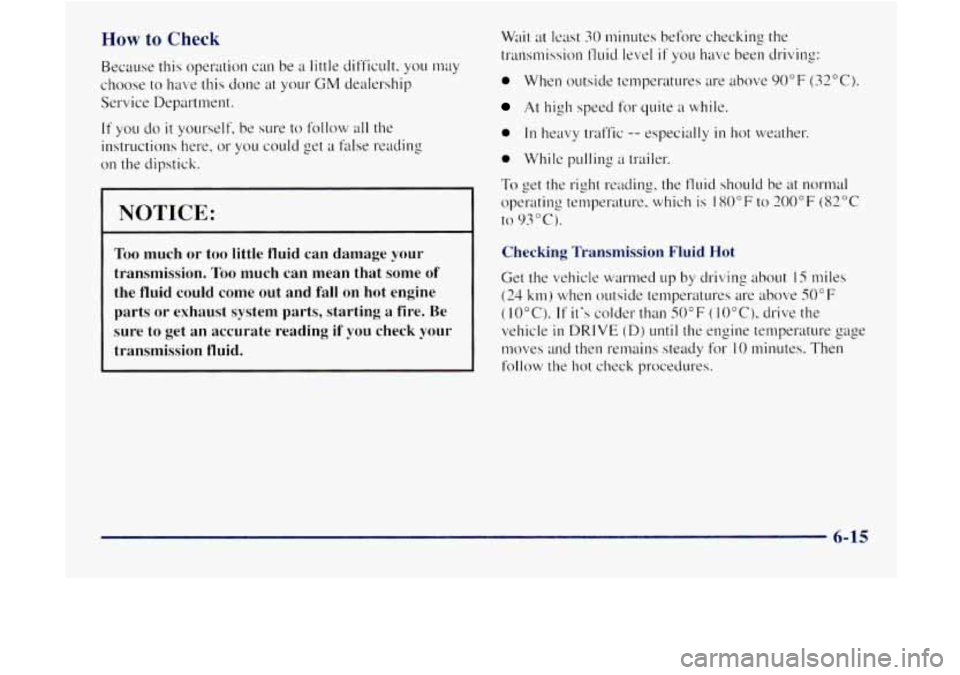
How to Check
Because this operation can be a little difficult, you may
choose to hm;e this done at your
GM dealership
Service Department.
If you do it yourself, be sure to follow all the
instructions here,
or you could get a false reading
on the dipstick.
NOTICE:
Too much or too little fluid can damage your
transmission.
Too much can mean that some of
the fluid could come out and fall on hot engine
parts or exhaust system parts, starting a fire. Be
sure
to get an accurate reading if you check your
transmission fluid.
Wait at least 30 minutes before checking the
transmission fluid level
if you have been driving:
0 When outside temperatures are above 90°F (32°C).
At high speed for quite a while.
0 In heavy traffic -- especially in hot weather.
0 While pulling a trailer.
To get the right reading, the fluid slwuld be at normal
operating temperature. which
is 180°F to 200°F (82°C
to 93°C).
Checking Transmission Fluid Hot
Get the vehicle warmed up by driving about 15 miles
(24 km) when outside temperatures are above 50°F
( 10°C). If it's colder than 50°F ( IOOC), drive the
vehicle
in DRIVE (D) until the engine temperature gage
rnoves and then remains steady for
10 minutes. Then
follow the hot check procedures.
6-15